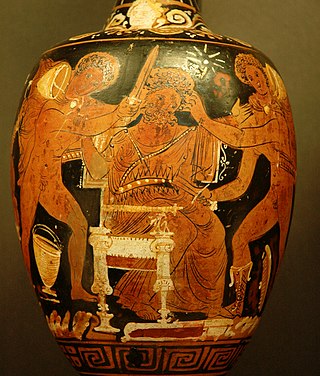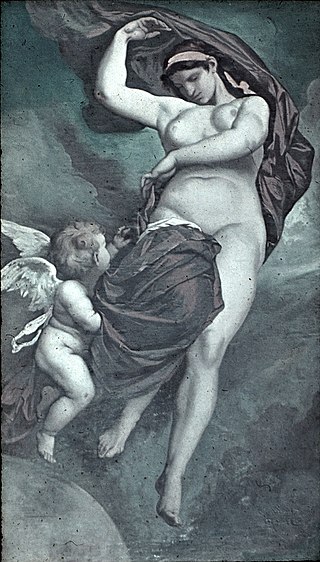See also
| | This article relating to a myth or legend from Australia is a stub. You can help Wikipedia by expanding it. |
In Karajarri mythology, Ngariman is a quoll-man who killed the Bagadjimbiri, two dingo spirits and sons of Dilga, an earth goddess. In revenge, she drowned Ngariman with her milk by flooding the cavern where he killed her sons.

Aegisthus was a figure in Greek mythology. Aegisthus is known from two primary sources: the first is Homer's Odyssey, believed to have been first written down by Homer at the end of the 8th century BC, and the second from Aeschylus's Oresteia, written in the 5th century BC. Aegisthus also features heavily in the action of Euripides's Electra, although his character remains offstage.

A centaur, occasionally hippocentaur, also called Ixionidae, is a creature from Greek mythology with the upper body of a human and the lower body and legs of a horse that was said to live in the mountains of Thessaly. In one version of the myth, the centaurs were named after Centaurus, and, through his brother Lapithes, were kin to the legendary tribe of the Lapiths.

The Norns are deities in Norse mythology responsible for shaping the course of human destinies.

In Greek mythology, Medea is a mythical granddaughter of the sun god Helios and a figure in the myth of Jason and the Argonauts. She aided Jason in his search for the Golden Fleece, married him, but later killed his children and his other bride. Medea is known in most stories as a sorceress and is often depicted as a priestess of the goddess Hecate. She also appears in Hesiod's Theogony around 700 BCE, but is best known from Euripides's tragedy Medea and Apollonius of Rhodes's epic Argonautica.

Amphion and Zethus were, in ancient Greek mythology, the twin sons of Zeus by Antiope. They are important characters in one of the two founding myths of the city of Thebes, because they constructed the city's walls. Zethus or Amphion had a daughter who was called Neis (Νηίς), the Neitian gate at Thebes was believed to have derived its name from her.

Aëdon was in Greek mythology, the daughter of Pandareus of Ephesus. According to Homer, she was the wife of Zethus, and the mother of Itylus. Aëdon features in two different stories, one set in Thebes and one set in Western Asia Minor, both of which contain filicide and explain the origin of the nightingale, a bird in constant mourning.

Clotho or Klotho, is a mythological figure. She is the youngest goddess of the Three Fates or Moirai. In ancient Greek mythology, she spins the thread of human life, her sisters draw out (Lachesis) and cut (Atropos) the thread. Her Roman equivalent is Nona. She also made major decisions, such as when a person was born, thus in effect controlling people's lives. This power enabled her not only to choose who was born, but also to decide when deities or mortals were to be saved or put to death. For example, Clotho resurrected Pelops when his father killed him.
In Greek mythology, Catreus or Katreus was the eldest son of Minos and Pasiphaë, and Minos' successor as king of Crete. Catreus had one son, Althaemenes, and three daughters, Apemosyne, Aerope and Clymene. Catreus was mistakenly killed by his son Althaemenes thereby fulfilling an oracle's prophecy.

In Greek mythology, Andromache was the wife of Hector, daughter of Eetion, and sister to Podes. She was born and raised in the city of Cilician Thebe, over which her father ruled. The name means 'man battler' or 'fighter of men' or 'man fighter' or 'man's battle', from the Greek stem ἀνδρ- 'man' and μάχη 'battle'.
In Greek mythology, the name Clite or Cleite may refer to:
In Greek mythology, Theano may refer to the following personages:
In Greek mythology, Podarces was a son of Iphiclus by Diomedeia and the brother of Protesilaus. In some accounts, he and his brother were called the sons of Phylacus and Astyoche instead.
In Karajarri mythology, the Bagadjimbiri are two brothers and creator spirits. They arose from the ground as dingos and made water-holes, sex organs for the androgynous first people, and invented circumcision. Taking human form, the Bagadjimbiri began an argument with Ngariman, a quoll-person. Ngariman was annoyed by the Bagadjimbiri's laughter. He killed the brothers underground, but was drowned by Dilga, their mother, who flooded the underground murder-spot with her milk, which also revived her sons. The Bagadjimbiri eventually turned into snakes and went to live in the sky as clouds.

Patricide is the act of killing one's own father. The word patricide derives from the Latin word pater (father) and the suffix -cida. Patricide is a sub-form of parricide, which is defined as an act of killing a close relative. In many cultures and religions patricide was considered one of the worst sins. For example, according to Marcus Tullius Cicero, in the Roman Republic it was the only crime for which the civilian could be sentenced to death.

Tāṭakā is a minor yakṣī antagonist in the Rāmāyaṇa. Along with her son, Mārīca, Tāṭakā would harass and attack sages performing yajñas in the forest. They were ultimately slain by Rāma and Lakṣmaṇa on behest of their teacher, Viśvāmitra.
In Greek mythology, Harpalyce is a name attributed to four women.

In Greek mythology, Gaia, also spelled Gaea, is the personification of the Earth. Gaia is the ancestral mother—sometimes parthenogenic—of all life. She is the mother of Uranus (Sky), from whose sexual union she bore the Titans, the Cyclopes, and the Giants; as well as of Pontus (Sea), from whose union she bore the primordial sea gods. Her equivalent in the Roman pantheon was Terra.

Polydorus or Polydoros is the youngest son of Priam in the mythology of the Trojan War. While Homer states his mother is Laothoe, later sources state his mother is Hecuba. Polydorus is an example of the fluid nature of myth, as his role and story vary significantly in different traditions and sources.
In Greek mythology, Theia is one of the three thousand Oceanid nymphs, daughters of the Titans Oceanus and Tethys, and the mother of the Cercopes. She is not to be confused with Theia, sister to Oceanus and Tethys and mother of Helios, Selene and Eos.